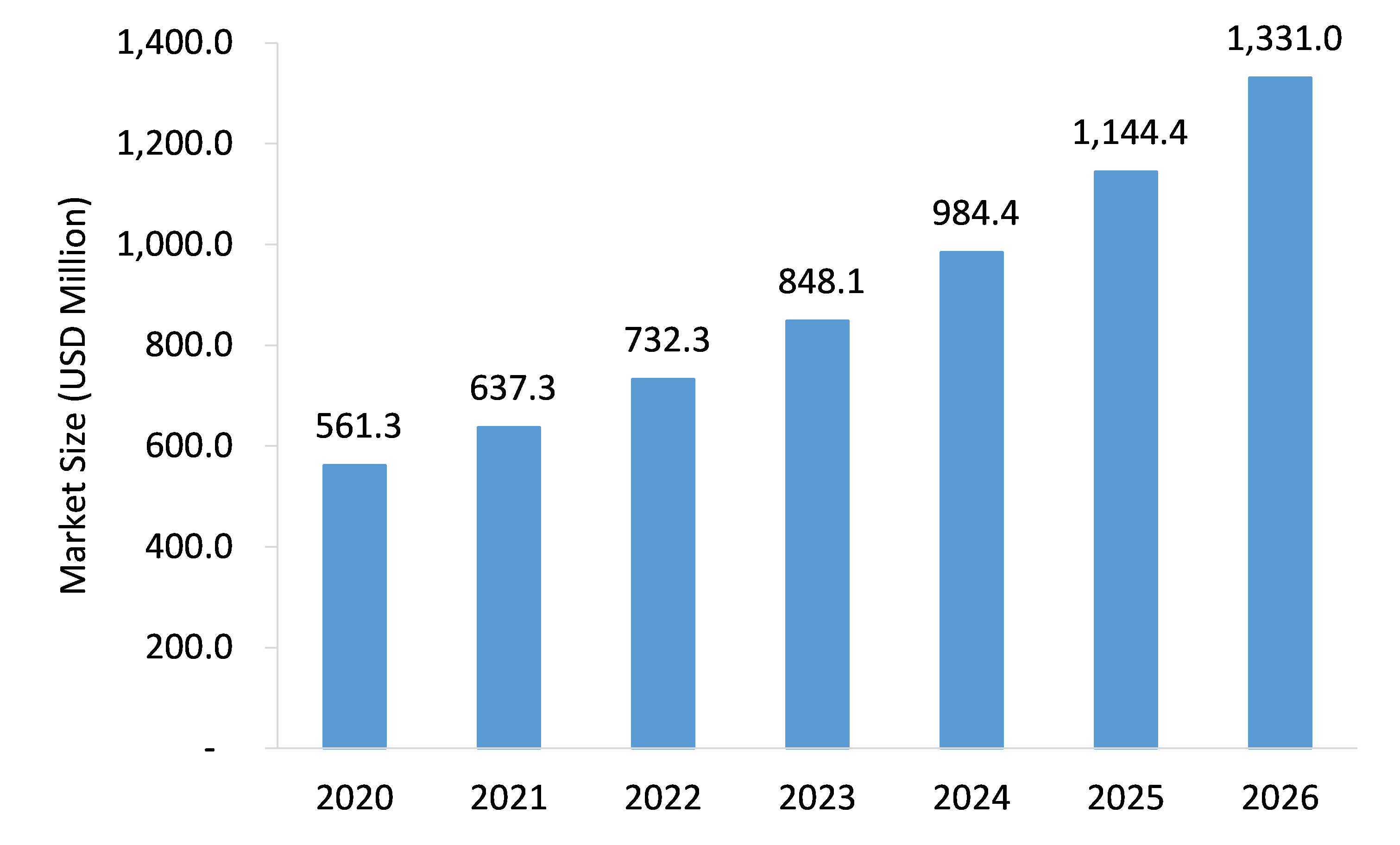Market Insights
What is Cell Culture Protein Surface Coatings?
Cell culture enables researchers to grow plant or animal cells in a suitable artificial environment. Protein-coated surfaces are currently employed for cell culture in understanding the different roles of proteins in cell attachment, migration, and function. In addition, it also helps in developing model systems for studying cellular functions, research, drug discovery stem cell research, and genetic engineering. A cell culture protein surface coating aids in improving the proliferation and adhesion of different cells, such as neurons, leukocytes, epithelial, and fibroblasts, in vitro isolation, and cultivation process. The inner surface of a petri dish or flask is usually coated with extracellular matrix or proteins such as collagen, laminin, fibronectin, and vitronectin.
The Cell Culture Protein Surface Coatings Market is estimated to grow from USD 561.3 million in 2020 to USD 1,331.0 million by 2026 at a healthy CAGR of 15.9% during the forecast period.
|
Cell Culture Protein Surface Coatings Market- Research Scope
|
|
Base Year of Study
|
2020
|
|
Trend Period
|
2015-2019
|
|
Forecast Period
|
2021-2026
|
|
Market Size in 2020
|
US$ 561.3 million
|
|
Market Size in 2026
|
US$ 1,331.0 million
|
|
Market Growth (2021-2026)
|
15.9% CAGR
|
Figure: Cell Culture Protein Surface Coatings Market Size, 2020-2026 (USD Million)

Wish to get a free sample? Register Here
Market Drivers
The growing occurrence of various chronic diseases across the globe is a key driving factor. Increasing the focus of market players on implementing better and innovative products with corrective and specific features is likely to augment the market growth. Moreover, the rising interest of scientists and numerous biotechnology companies in cancer & stem cell research is accelerating worldwide which is likely to offer immense growth opportunities to the product manufacturers. Stem cells are effective in treating brain diseases, cancer, cell deficiency therapy, and cardiovascular diseases. However, the high cost of cell culture protein surface coatings products is expected to limit the cell culture protein surface coatings usage in the following years.
Covid-19 Impact Analysis
The outbreak of COVID-19 moderately impacted the cell culture protein surface coatings industry as the pandemic adversely affected the international trade activities, supply chains, and manufacturing activities across the globe. However, there was a huge burden on biopharmaceutical and research centers to innovate medicines and vaccines to treat COVID-19, which is likely to increase the government funding, thus positively influencing the market growth amid the pandemic.
Segments' Analysis
Protein Source Trends
Based on a protein source, the cell culture protein surface coatings market has been divided into animal-derived, human-derived, synthetic, and plant-derived. The synthetic segment held a significant market share in 2020. Synthetic proteins possess a relatively lower risk proposition, as they are less prone to contamination. Also, it has widespread applications such as the potential early treatment of diseases like diabetes and cancer, thus boosting the segment growth.
Regional Trends
By region, the North American Cell Culture Protein Surface Coatings market accounted for the largest share of almost 40% in 2020 and is expected to grow at a significant CAGR during the review period. The cell culture protein surface coatings market growth can be ascribed to a large presence of leading biotechnology companies, highly developed healthcare & research infrastructure, strong focus on drug discovery, and easy availability of improved cell culture laboratories.
The Asia-Pacific Cell Culture Protein Surface Coatings market is expected to grow at the highest CAGR during the review on account of the growth of the major end-use industries. This growth is mainly ascribed to the presence of many clinical research organizations & biopharmaceutical companies in China, Japan, and India for drug discovery and development. Also, less stringent regulations for biologic product development, easy availability of a vast genome pool, and improving healthcare infrastructure further bolster the regional market growth during the review period.
Critical Questions Answered in the Report
This market research report provides in-depth information on trends, dynamics, revenue opportunities, competitive landscape, and recent developments in the global cell culture protein surface coatings market. The historic years considered for the study are 2016-2019, the base year is 2020, the estimated year is 2021, and the forecast period is 2022-2026. Following are the critical questions answered in the report.
- What are the key trends in the cell culture protein surface coatings market?
- How the market (and its various sub-segments) has grown in the last five years and what would be the growth rate in the next five years?
- What is the impact of COVID-19 on the cell culture protein surface coatings market?
- What are the key strategies adopted by the major vendors to lead in the cell culture protein surface coatings market?
- What is the market share of the top vendors?
Get the full scope of the report. Register Here
Key Players
Key players operating in the Cell Culture Protein Surface Coatings Market are-
- Kollodis BioSciences (US)
- Abcam PLC (UK)
- Corning Incorporated (US)
- Greiner Bio-One International AG (Austria)
- Merck KGaA (Merck Millipore) (Germany)
- Promega Corporation (US)
- Qiagen NV (Germany)
- Sartorius Stedim Biotech SA (France)
- Thermo Fisher Scientific Inc. (US)
- Viogene BioTek Corporation (Taiwan)
Target Audience
The target audience of Cell Culture Protein Surface Coatings Market includes-
- Cell Culture Protein Surface Coatings Vendors
- Cell Culture Protein Surface Coatings Manufacturers
- Cell Culture Protein Surface Coatings Distributors
- Organizations
- Government Bodies.
Custom Research: Stratview research offers custom research services across sectors. In case of any custom research requirement related to market assessment, competitive benchmarking, sourcing and procurement, target screening, and others, please send your inquiry at sales@stratviewresearch.com.

